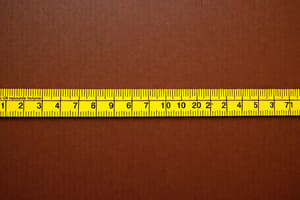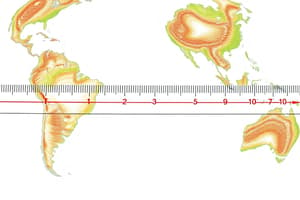Podcast
Questions and Answers
What does the magnitude of an earthquake primarily measure?
What does the magnitude of an earthquake primarily measure?
- The frequency of seismic waves.
- The shaking felt at different locations.
- The energy released at the earthquake's source. (correct)
- The duration of the ground shaking.
The Richter scale is a base-10 logarithmic scale. What does this mean regarding the wave amplitude between a magnitude 4 and 6 earthquake?
The Richter scale is a base-10 logarithmic scale. What does this mean regarding the wave amplitude between a magnitude 4 and 6 earthquake?
- The wave amplitude in a magnitude 6 earthquake is 100 times greater. (correct)
- The wave amplitude in a magnitude 6 earthquake is two times greater.
- The wave amplitude in a magnitude 6 earthquake is 10 times greater.
- The wave amplitude in a magnitude 6 earthquake is 20 times greater.
What is the relationship between the magnitude of an earthquake and the energy released?
What is the relationship between the magnitude of an earthquake and the energy released?
- There is no direct relationship between magnitude and energy released.
- A one unit increase in magnitude represents 100 times greater increase in energy released.
- A one unit increase in magnitude represents an approximately 31.7 times increase in energy released. (correct)
- A one unit increase in magnitude represents a 10 times increase in energy released.
How are earthquake magnitudes primarily determined?
How are earthquake magnitudes primarily determined?
Seismometers are key in measuring earthquakes. What do they primarily record?
Seismometers are key in measuring earthquakes. What do they primarily record?
Who developed the method for calculating earthquake magnitudes that has been used for several decades?
Who developed the method for calculating earthquake magnitudes that has been used for several decades?
According to the Richter scale, if an earthquake has an amplitude of 100 $mm$ recorded on a seismograph, and another earthquake has an amplitude of 10,000 $mm$, how much greater is the magnitude of the second earthquake compared to the first?
According to the Richter scale, if an earthquake has an amplitude of 100 $mm$ recorded on a seismograph, and another earthquake has an amplitude of 10,000 $mm$, how much greater is the magnitude of the second earthquake compared to the first?
What does the term 'logarithmic scale' mean regarding the Richter scale?
What does the term 'logarithmic scale' mean regarding the Richter scale?
Flashcards
Earthquake Magnitude
Earthquake Magnitude
The energy released at the source of an earthquake. Measured using seismograph readings.
Richter Scale
Richter Scale
A numerical scale used to compare the relative strength of earthquakes based on the energy released.
Seismometers
Seismometers
Instruments that detect and record ground vibrations caused by earthquakes.
Epicenter
Epicenter
Signup and view all the flashcards
Richter Scale Wave Amplitude
Richter Scale Wave Amplitude
Signup and view all the flashcards
Focus
Focus
Signup and view all the flashcards
Energy Release on Richter Scale
Energy Release on Richter Scale
Signup and view all the flashcards
Earthquake Intensity
Earthquake Intensity
Signup and view all the flashcards
Study Notes
Earthquake Magnitude and Intensity
nergy released at the earthquake's source, determined from seismograph measurements.
- Magnitude allows comparison of earthquake power.
- Early magnitude calculations utilized the Richter scale, developed by seismologist Charles Richter.
- Richter calibrated the scale using seismEarthquake magnitude measures the eograms from the San Andreas fault zone earthquakes.
- Earthquake location, time, and magnitude are derived from seismometer data.
- Seismometers record ground vibrations from earthquakes.
- Each seismometer records ground shaking directly below it.
- Advanced instruments magnify ground motions to detect earthquakes globally.
- Modern systems precisely record ground motion variations (0.1 to 100 seconds).
Richter Scale
- The Richter magnitude scale quantifies earthquake size, established in 1935.
- It's a logarithmic scale (base 10), each whole number representing a tenfold increase in intensity.
- Magnitude is determined from the logarithm of seismograph-recorded wave amplitudes.
- Adjustments account for varying distances between seismographs and the earthquake epicenter.
- A level 6 earthquake has 10 times greater wave amplitude compared to a level 5.
- The energy released increases 31.7 times between each whole number on the scale.
Studying That Suits You
Use AI to generate personalized quizzes and flashcards to suit your learning preferences.




